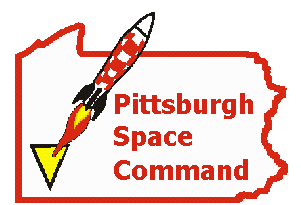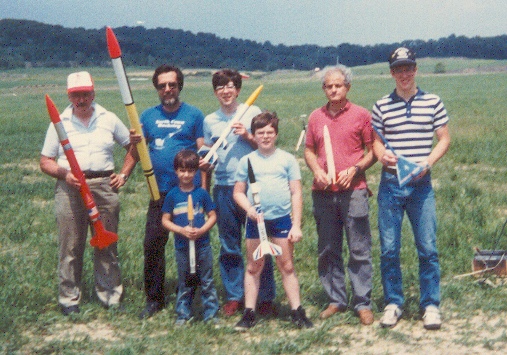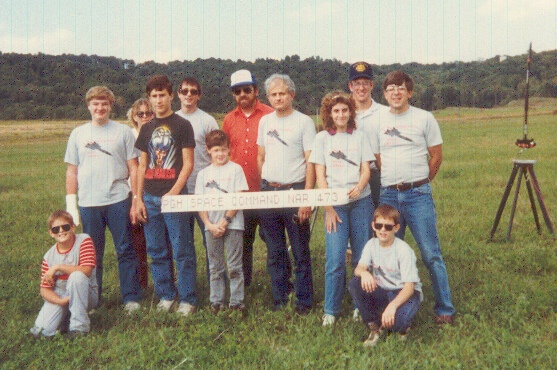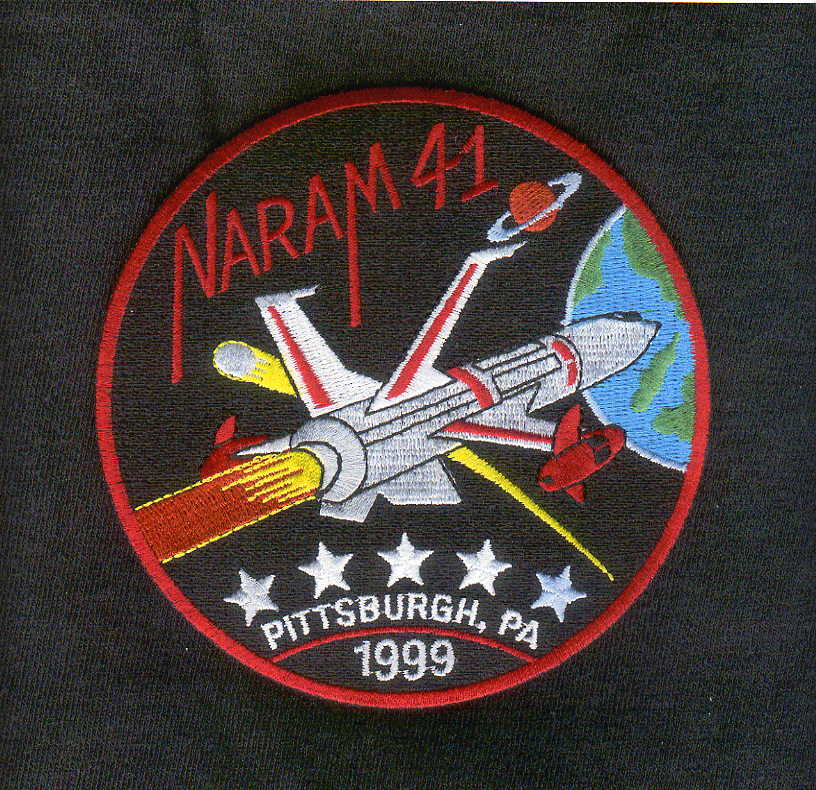
The History Of Pittsburgh Space Command

By Art Nestor, NAR# 29623
Part 1

The History Of Pittsburgh Space Command

By Art Nestor, NAR# 29623
Part 1
Already having developed a healthy appetite for science fiction and NASA's race to the moon in the early sixties, I was simply astonished one day in 1966 to see an Estes Industries catalog. I was in eighth grade and waiting in the Evans City Jr. High School gymnasium for my bus to take me home. Sitting on the bleachers was a student I didn't know looking at the catalog. At that point, Estes Industries became a legend in my young eyes. Although always primarily a sport flyer, I took my rocketry program very seriously. I recorded all of my earliest launches on Estes' flight data sheets and later created my own for my experiments in aerial photography with the CAMROC aerial camera. This desire to record information now provides me with a lot of valuable personal data and continued when I later organized PSC. My best friend and neighbor, Jim Benek had his own equally serious rocketry program. We had a good natured rivalry and some great misadventures. Numerous times during those early years (1966 - 1971) I received a NAR application but didn't join. Once Jim even attended a Pittsburgh Spring Convention hosted by The Steel City Section. I regret to this day that I didn't go with him. But still neither of us joined. The final flight of my early years occurred on July 4th, 1971. It was a Flight Systems Voyager rocket on an F100-8 motor. I was getting ready to attend the University of Pittsburgh. I shelved model rocketry.
It wasn't until 1976 that I regained an interest in our hobby while acquainting my niece and nephew to model rocketry. What a difference five years made. I quit college, got married and now had a two year old daughter, Candace. I immediately set out with a vengeance to do everything I had never done as a teenage flyer. I made a list of goals. Some of my goals were to master 3 and 4 engine clustering, 3 stage rockets, to obtain exceptional aerial photographs, write for Model Rocket News, fly the Cineroc and find model rocket catalogs from before I entered the hobby. As each goal was attained I became more enthusiastic. New goals were added to the list as others were crossed off. One later goal was to join NAR and I did in 1978. Another was to seek out Steel City or Three Rivers Section and possibly join. (I was unaware of the short-lived South Pittsburgh Area Rocket Club). When I learned they were no longer around that goal was changed to restore a Pittsburgh NAR section to active status. I started working on that goal in 1985.
Two people that were instrumental in assisting me in the formation of PSC were Claud T. Greenlee and former NAR President J. Patrick Miller. At the time Claud was a NAR Trustee and Chairman of both the Education Committee and the Membership Committee. I have had the pleasure of meeting them both in person. I tried to organize PSC in 1985 but could not obtain, for one reason or another, a local membership list from NAR. Although a complete membership listing of about 3000 names was available from headquarters for about $40, free assistance in forming new sections was advertised in the NAR journal, The Model Rocketeer. I brought my problem to Claud Greenlee in a letter dated May 27, 1985. Claud acknowledged my problem in obtaining information on local NAR members in a letter dated June 02 and immediately forwarded copies of our letters to President Miller (Pat). Pat in turn brought it to the attention of the Chairman of the Section Activities Committee. After many months I received a state membership list. But it was a poor unreadable photocopy. Useless. Out of the blue shortly thereafter, Pat sent me a new local list based on zip codes above and below that of mine, 16063. Also pretty much useless. Many of those zip codes yielded NAR members in small towns a good distance away. Definitely not Pittsburgh! It was now April 1986, about 1 year since I first attempted to organize. I wrote Pat to request listings specifically for Pittsburgh and Beaver Valley zip codes. Paydirt!
I created a cover letter and application form. The cover letter stated that a new NAR section, the North Pittsburgh Space Command, was forming and anyone joining now would be a charter member. About 30 applications were mailed and 9 people responded. Mort applied first on April 18th. He had also flown with the Steel City section. Had I acted a few years earlier and joined Steel City, I'm confident Mort and I would have saved that section from disbanding. We would be the same bunch of flyers today but with a completely different history and name. PSC became a section before we held our first meeting or launch. Our club was chartered on May 05, 1986 and our first launch occurred on June 01.
In the early days of PSC you had to submit a signed and dated application form to join. I numbered each application as I received it. Hence, we now know when and in what order the first 50 or so members joined the club. The founding PSC members were #1 Art Nestor, #2 Mort Binstock, #3 Erik Schall, #4 Rod Schafer, #5 Tom Blazanin, and #6 Mike Kalmar. The following members joined later but during the first year: # 7 Jed Blazanin, #8 Joseph Mary, #9 Joseph Yanni, #10, Bill Kust, #11 Jim Galasso, Jr., #12 Stan Klepacz Sr., #13 Bill Fryer, #14 Kent Parkhill, #15 Herman Funk, #16 Stephen Hart, #17 Kenn Pattison, #18 John Sarosi, and (officially) #19 Peg Nestor.
For better or worse, I came up with the name Pittsburgh Space Command. I had considered the name North Pittsburgh Space Command because I lived in Zelienople but shortened it to PSC at the last minute. The name was inspired by a news item I read in the Washington Calling section of THE PITTSBURGH PRESS. The item referred to a proposed new branch of the armed services comprised of astronauts and to be called the United States Space Command. The name was never put up for a vote. Remember I was goal oriented and had waited a year now. When I obtained enough applications, I applied for a NAR charter. I have often wondered whether people thought it was too corny. In a phone call to Tom Blazanin before the club was chartered, I expressed that thought. He suggested we name it something so the initials would spell a word. It was a very popular idea at the time. Also popular was the use of the word society. I didn't want popular. Here's where another fork in the road could have changed the club. He also suggested the name TEAM PITTSBURGH! It was tough to decide but of course in the end I instead named our newsletter Team Pittsburgh.
Our first launch was held off Lower Butler Road, Harmony, Pa. This launch field later became known as the Z field for Zelienople. Z field was an early high power launch field for Tripoli as it transformed to national status under the direction of our own Tom Blazanin. Nine members attended the first launch. They were Mort Binstock, Tom and Jed Blazanin, Mike Kalmar, Joseph Mary, Erik Schall, Rod Schafer, my wife Peg and myself. Although Peg had not yet joined NAR, she had assisted in the formation of the club and was considered a member. Joseph and Erik never attended a second launch. Mike, Tom and Jed were faithful club members until they moved away. Rod couldn't drive yet so his whole family came out. Sorry Rod, but my most vivid memory of our first launch was my calling you Rodney to the delight of your giggling sisters. I was afraid I had embarrassed you. Rod was our first Range Safety Officer. Joseph Mary was "elected" Vice President. I seem to remember no one stepped forward and I pressured him to take it. Maybe that's why he never came back!
 |
|
The First PSC Launch June 1, 1986 |
Tom Blazanin supplied a 6 position launch controller and a wooden launch rack made of 2 x 4's. He later donated the red steel rack and launch controller both still in use today. I stored the wooden rack for many years but eventually threw it out. The launch controller has been reworked at least once.
The first issue of Team Pittsburgh was dated August, 1986. In the first year the newsletter was published monthly. Most issues were 4 pages. I greatly dislike it when section newsletters are numbered in volumes. For example the fourth issue of a club's third year is volume 3 # 4. Club newsletters tend to be published erratically and volume numbering makes it very difficult for collectors to know how many issues were published in a given year or in total. To my knowledge our club is the first in modroc history to celebrate a 100th issue. This was a major problem in trying to collect every issue of Estes Model Rocket News, which also had a volume numbering system. But I did convince editor Mike Hellmund to count as best as possible every MRN and convert to a dual numbering system like Team Pittsburgh has now.
For the first few months of the club there were no dues. I organized it, paid for the section charter, initially paid for the newsletter printing costs (members contributed stamps for newsletter postage and later money on a volunteer basis for the printing) and served as President, section advisor and newsletter editor. Believe me I'm bragging not complaining. I had the opportunity and good fortune to be a part of creating Pittsburgh model rocket history. A respected and well known legacy that continues to this day. Few other rocketeers can say that.
Our Section colors of red, gray and black were adopted the first year. It was decided at a section meeting at Bill Kust's house. Black and gold (or yellow) were considered because of the Pirates and Steelers but decided against since they were also the colors of Aerotech.
Mort came up with a cool ongoing contest idea in our first year. It was called the 600mph Club. He created a computer program that computed altitude when certain factors such as engine size and body diameter were input. The rules were that your rocket and its' actual flight parameters must indicate a speed of at least 600mph, the rocket must not shred in flight and the rocket be recovered. The prize to each winner was a verifying computer printout and an antique Model Missiles Inc. A8 motor. Mort had purchased these motors at Bill and Walt's hobby shop around 1959. At NARAM 41 they sold at auction for over $100 each. A worthy prize! This contest quickly became a favorite of the PSC and is stilled talked about to this day. He later renamed the contest "600 mph or Bust" because that's what usually happened.
Early interest in competition resulted in contests as soon as our second launch. Competition in our first year was not sanctioned. We did not accrue national flight points or fly in age divisions. They were fun events. Tom Blazanin organized our first competitions. As interest grew, members wanted more serious contests. But since I was already wearing three hats and still had my own rocketry interests, the NAR Pink Book was more than I wanted to tackle.
In an attempt to make the club more interesting, I created a Section Flight Point System and used the membership to form a Young Astronaut Club. The point system was easily administered and was a substitution for national points. Members got recognition points for all sorts of things such as winning contests or renewing membership. I thought the Young Astronaut Club would generate material for the newsletter's younger readers.
At our November 14, 1986 club meeting Mort was first elected Vice President. Mort and Rod have been and are recognized as extremely loyal and supportive longtime PSC members. Both have rivaled and in numerous instances surpassed my contributions to PSC. But I would be remiss not to draw your attention to John Sarosi. Since his joining PSC, I have never noticed a loss of enthusiasm or loyalty on his part. Along with my wife Peg, the five of us are the only remaining members from the first year.
 |
|
PSC Launch - Summer 1987 Kneeling: Stan Klepacz Jr. and Matt Klepacz or vice versa. Sorry it's been too long |
End Of Part 1 - More To Follow
Part 2 - Part 3
In Aug of 1999 Pittsburgh Space Command hosted NARAM 41.
Here is the history on its patch.
A Bit of History - By Art Nestor
 |
...The patch design was inspired by the cover of the Fall ...1980 ESTES Industries seasonal sale catalog. The rocket ...depicted on the patch is the INTERCEPTOR. ...There are six stars representing six Pittsburgh area rocket ...clubs. It looks now like the final design will have only five. ...The reason being that I cannot obtain a complete section ...listing to determine the total number of sections that may ...have existed in the greater Pittsburgh area. Hence, we ...will recognize only those sections known to actually have ...incorporated the name Pittsburgh in some form in its name. |
| ...1st star is silver for the PSC #473 ...2nd star is white for Steel City Section # ...3rd star is white for Three Rivers Section # ...4th star is white for South Pittsburgh ........Area Rocket Club ...5th star is sky blue for Tripoli Pittsburgh ........Prefect #1 and Tripoli National |
........The Interceptor is white ........The background is black ........The red arc remains the same ........The planet pictured is not Earth ........The small circle to the left of the planet ...........will be a ringed planet ........Pittsburgh and 1999 will probably be silver |